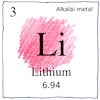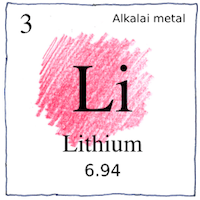Stockholm, London—Johan August Arfwedson,
William Thomas Brande
elements

|
Lithium
José Bonifácio de Andrada e Silva discovered a lithium aluminium phyllosilicate crystal in a mine on the island of Utö, Sweden, in 1800, but he didn’t know it contained a new element which Johan August Arfwedson determined in 1817. Arfwedson let Jöns Jacob Berzelius name after the Greek for “stone,” but they weren’t able to isolate the element which William Thomas Brande did in 1821 using electrolysis of lithium oxide.
Atomic number 3
Lithium is the lightest metal, the least dense solid element at room temperature, highly reactive, and flammable It’s used for heat-resistant glasses and ceramics, for lubricating greases that are non-corrosive, for fireworks that burn red, for treating bipolar disorder, and for rechargeable batteries.
Lithia waters
The acclaimed lithia water of Ashland, once reputed beneficial to the heart and brain and available free from a fountain at the center of town, results in a substantial shock to the system.



Lithium may yet provide a cure for what ails us, or at least for what ails our planet. Lithium air batteries could theoretically provide five to fifteen times the specific energy of lithium-ion batteries, competing well with gasoline and diesel.
See also in The book of science:
Readings in wikipedia:
Other readings: